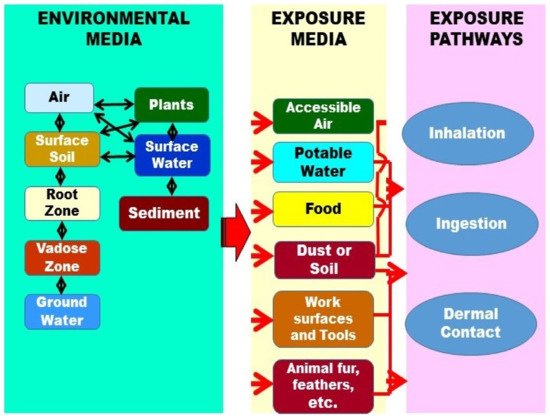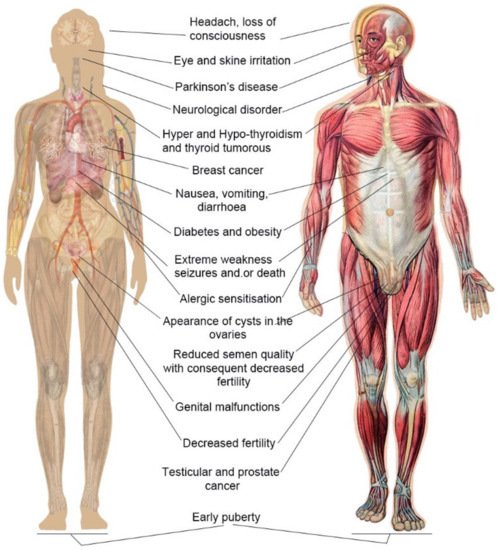There are four main pesticide application methods, including hydraulic spraying, backpack spraying, basal trunk spraying, and aerial spraying. Pesticide application methods are mainly selected by considering the habits of target pests, the characteristics of target sites, and the properties of pesticides. Humans are directly exposed to pesticides in occupational, agricultural, and household activities and are indirectly exposed to pesticides via environmental media, including air, water, soil, and food. Human exposure to pesticides occurs mainly through dermal, oral, and respiratory routes. People who are directly and/or indirectly exposed to pesticides may contract acute toxicity effects and chronic diseases. Although no segment of the general population is completely protected against exposure to pesticides and their potentially serious health effects, a disproportionate burden is shouldered by people in developing countries. Both deterministic and probabilistic human health risk assessments have their advantages and disadvantages and both types of methods should be comprehensively implemented in research on exposure and human health risk assessment. Equipment for appropriate pesticide application is important for application efficiency to minimize the loss of spray solution as well as reduce pesticide residuals in the environment and adverse human health effects due to over-spraying and residues. Policymakers should implement various useful measures, such as integrated pest management (IPM) laws that prohibit the use of pesticides with high risks and the development of a national implementation plan (NIP) to reduce the adverse effects of pesticides on the environment and on human health.
1. Introduction
Pesticides play an important role in agricultural development as they can reduce the loss of agricultural products and improve the affordable yield and quality of food
[1][2][3][1,2,3]. Owing to the urgency to improve food production and control insect-borne diseases, the development of pesticides increased during World War II (1939–1945), and from the 1940s onwards, the increased use of synthetic crop protection chemicals permitted a further increase in food production
[4]. Moreover, pesticide production worldwide has increased at a rate of about 11% per annum, from 0.2 million tons in the 1950s to more than 5 million tons by 2000
[5]. Three billion kilograms of pesticides have been consumed worldwide every year
[4], while only 1% of total pesticides were effectively used to control insect pests on target plants. The remaining large amounts of pesticides go into or reach non-target plants and environmental media. As a result, pesticide contamination has significantly polluted the environment and caused adverse impacts on human health
[6][7][8][6,7,8].
Equipment for appropriate pesticide application is important for application efficiency
[9] to minimize the loss of spray solution as well as reduce pesticide residuals in the environment and adverse human health effects due to over-spraying and residues. Humans are directly exposed to pesticides in the workplace
[10] and indirectly through environmental media, such as air, water, soil, and the food chain, which may be contaminated with pesticides
[11][12][11,12]. Dermal, oral, and respiratory routes are the main common pathways by which pesticides enter the human body
[13][14][13,14]. According to a WHO and UNEP report, worldwide, three million people are poisoned and 200,000 die due to pesticide exposure
[15].
2. Routes of Pesticide Exposure
People are not only directly exposed to pesticides in occupational, agricultural, and household activities
[16][17][18][37,38,39] through different application methods
[19][40], they are also indirectly exposed to pesticides via contaminated environmental media, including air, water, soil, and food
[10][11][20][21][22][10,11,41,42,43]. These different types of exposure determine the degree of toxicity of pesticides
[6][13][19][6,13,40]. The main ways pesticides come into contact with the human body are through the dermal, oral, and respiratory routes (
Figure 12)
[10][23][24][25][26][27][10,33,44,45,46,47].
Figure 12.
Routes of exposure to pesticides.
3. Human Health Effects Related to Pesticide Exposure
Owing to pesticides’ important role in agricultural development, there is a heavy dependence on pesticide applications to meet the huge demand for food production by an increasing population. This causes environmental stress and has detrimental health effects on humans worldwide
[9][28][9,74]. The high-risk groups directly exposed to pesticides are workers, formulators, sprayers, mixers, loaders, and agricultural farm workers
[4][29][30][4,75,76]. During manufacturing and formulation, contact with hazardous materials and situations are greatly increased, as the processes involved are not risk-free. Moreover, workers are directly exposed to pesticides via their hands and by inhaling chemicals in the air phase. In industrial settings, workers are also at an increased risk because they need to handle various toxic chemicals, including pesticides, raw materials, toxic solvents, and inert carriers
[31][77]. Humans are also indirectly exposed to pesticides from contaminated soil, air, water, and the food chain
[10][11][14][10,11,14]. Humans can be exposed to pesticides in a multitude of ways, both directly and indirectly (Phung et al.)
[32][16], which cause different health effects
[33][34][78,79] (
Figure 23).
Figure 23.
Health problems due to pesticide exposure.
People who are both directly and indirectly exposed to pesticides may suffer acute toxic effects, including suicide attempts, mass poisoning from contaminated food, chemical accidents in the industry (WHO, 1990), occupational exposure in the agricultural industry
[35][36][37][38][80,81,82,83], and a number of serious chronic diseases
[5][24][5,44], including cancer, asthma, diabetes, Parkinson’s disease, leukemia, and cognitive impairment
[11][14][38][39][11,14,83,84]. Many cases of intoxication of farmers, rural workers, and their families during pesticide application in agricultural activities have been identified
[40][41][42][43][44][45][85,86,87,88,89,90]. There have also been reports of poisoning and the effects of chemicals on human health from the environment and contaminated food
[46][47][48][49][50][51][60,91,92,93,94,95]. According to the WHO, unintentional poisonings kill an estimated 355,000 people globally each year, and poisonings are strongly related to excessive exposure and inappropriate use of toxic pesticides
[35][80].
3.1. Acute Toxic Effects
Acute toxic effects occur within a few minutes to several hours after poisoning by pesticides
[31][52][53][54][77,96,97,98]. Poisoning impacts peripheral muscarinic and nicotinic receptors, as well as the central nervous system
[55][56][57][58][59][99,100,101,102,103]. Some manifestations of a cholinergic crisis include nausea, vomiting, diarrhea, abdominal cramp, urinary incontinence, miosis, salivation, lacrimation, bronchorrhea, bradycardia, hypotension, fasciculation, muscle paralysis, dizziness, confusion, seizures, coma, and respiratory failure
[8][56][58][60][61][62][8,100,102,104,105,106]. These effects may occur immediately with exposure to pesticides
[63][64][65][66][107,108,109,110]. Moreover, if life-threatening complications are not properly and immediately treated, death can also occur
[67][68][69][111,112,113].
3.2. Chronic Disease
It has been documented that various chronic diseases and disorders occur after people have been exposed to pesticides
[70][71][72][117,118,119], including cancers, adverse reproductive outcomes
[73][120], male sterility
[74][121], peripheral neuropathies
[75][122], neurobehavioral disorders
[76][123], impaired immune function (Nankongnab et al., 2020)
[77][124], and allergic sensitization reactions, particularly of the skin
[78][79][80][125,126,127]. Moreover, most of the pesticides examined affect male reproductive systems
[77][78][79][80][81][124,125,126,127,128], causing sperm damage
[71][118], DNA damage
[82][129], and abnormal sperm morphology
[13]. As an example, cumulative inhalation of cholinesterase activity as a result of long-term, low-dose exposure to organophosphorus compounds leads to chronic diseases
[78][125]. Antonine et al.
[74][121] tested the effects of low concentrations of Glyphosate; the decrease observed in levels of Clusterin mRNAs suggested that glyphosate targets the integrity of Sertoli cells. The decrease in the numbers of germ cells from day 14 onward highlighted the chronic effect of glyphosate at 50 nm, 500 nm, or 5 μm. Meltzer et al.
[83][115] aimed to evaluate self-reported exposure to the Ringwood Mines/Landfill Superfund Site in relation to chronic health outcomes among members of the Ramapough Lunaape Turtle Clan nation and other residents of Ringwood, New Jersey. The results of the study indicated significant associations among Ringwood residents of Native American ethnicity between health issues and self-declared opportunities for Superfund site exposure. The results also showed a strong association between self-reported Superfund site exposure and the prevalence of bronchitis and asthma. Vanlaeys et al.
[81][128] tested glyphostate alone, glyphosate-based herbside formulations, and POEA on an immature mouse Sertoli cell line (TM4) at concentrations ranging from environmental to agricultural-use levels; the results indicated that formulations of glyphosate-based herbicides induce TM4 mitochondrial dysfunction, disruption of cell detoxification systems, lipid droplet accumulation, and mortality at sub-agricultural doses. The results also showed that formulants, especially those present in Glyphogan, are more deleterious than glyphosate. Séralini et al.
[33][78] discussed a 90-day feeding study which was conducted by Monsanto in order to achieve commercial release of this GMO, employing the sane rat strain and analyzing biochemical parameters in the animals. The results showed that in the treated males liver congestion and necrosis were 2.5 to 5.5 times higher than in the control groups. Marked and severe nephropathies were generally 1.3 to 2.3 times greater. In females, all treatment groups showed a two- to three-fold increase in mortality, and deaths occurred earlier. Males had more than four times the frequency of mammary tumors of the controls.


